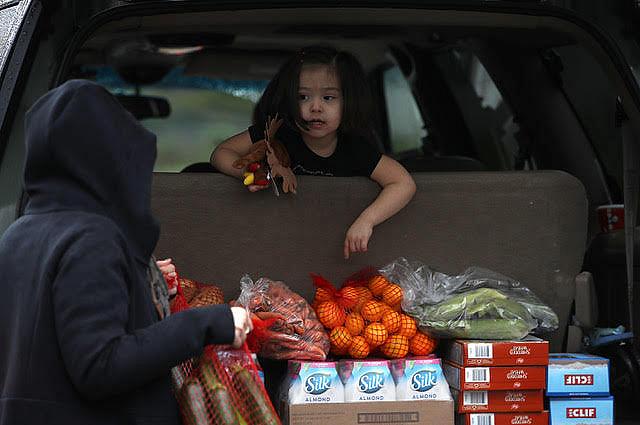Can joining a city help this neighborhood become healthier?

A young girl looks on as a volunteer loads food into a car at a food bank in Santa Rosa, California. (Photo: Justin Sullivan/Getty Images)
Until recently, the Roseland neighborhood was surrounded by the city of Santa Rosa, California, but separate from it. Local politicians have long tried to find ways to better serve residents there, but for years this unincorporated section of Sonoma County has had to make do with a patchwork of services. The area, with some 7,400 mostly Latino residents, was finally annexed and became part of Santa Rosa on November 1, 2017.
What are the expected benefits of annexation? For one thing, the area will fall under the protection of the Santa Rosa Police Department, rather than the Sonoma County Sheriff’s Office, which has a fraught history with residents. There’s also the near-certainty that in two years, the neighborhood will be able to elect a city councilmember who truly represents its interests.
The idea for a joint project between community radio station KRCB and bilingual community station KBBF arose as both looked to expand their reach with audiences they don’t always speak to. This followed the fires of October, 2017 when both stations were communicating essential safety information and were rewarded with increased visibility and a sense of an expanding mission.
As we began to talk with people in the southwest quadrant of Santa Rosa, especially residents and nonprofits active in Roseland, a large question arose: How might the annexation of Roseland become a fulcrum to improve the health of residents? Looked at another way, if the city of Santa Rosa embraces its responsibility to make life better for the residents of Roseland, how can two small community media organizations help channel the voices of lower-income residents in the neighborhood to make their needs known?
Before beginning the project, supported by a grant from the Center for Health Journalism’s Impact Fund, we learned about health-related efforts already underway in the neighborhood. One such program encourages residents to become aware of their blood pressure readings, so they can receive early treatment. Another initiative sought to replace soda machines in schools and parks with water dispensers.
How can we help improve health in the neighborhood? We plan to start by listening. And we’re experimenting with the best ways to do that.
At a recent community event, the opening of a neighborhood park dedicated to the memory of a young Latino boy shot by a county sheriff’s deputy, we encouraged those who stopped by a table promoting KBBF to fill out a questionnaire about health in the neighborhood. We asked how important certain social determinants of health would be to the respondents, naming everything from housing to anxiety over immigration status to transportation, parks and infrastructure.
Not surprisingly, nearly all of those who filled in the questionnaire checked housing. The housing crisis here has been made immeasurably worse by the destructive fires that obliterated 3,000 residences in Santa Rosa.
We were heartened to learn that nearly all of those surveyed seemed to share our understanding that health includes everything from education to parks.
As we prepare for a meeting of community stakeholders, we’ll once again be in listening mode. We’ve identified more than a dozen groups and government entities actively working in the neighborhood on projects they consider essential to improving health. We imagine their representatives go to endless meetings and were a bit anxious about whether they would want to attend another one. But then word began to reach us that some of these groups had already been strategizing on making better use of the media to get key health messages out to the community. They saw our invitation as a step in that direction.
Right now, we’re still in the process of learning what our role will be as we dive into this project. If the subject of a news story is testing for high blood pressure in the neighborhood, is it our responsibility to present the information in a way that gets people to come and be tested? Do we need to explain what people should do if they get a worrying result? Or is it merely our job to report on the program that encourages testing and provide preliminary data on the findings?
Other questions are even more complex. KRCB broadcasts exclusively in English, while KBBF serves an audience that is both monolingual Spanish speaking and bilingual. How will that affect the stories we tell and how we present them on each of our outlets? How should we structure live events, starting with our stakeholders meeting, to make sure that nobody feels they are being addressed in a language they aren’t fully comfortable with?
Then there are the practical challenges. Both stations are expecting to receive key information from call-in programming presented in Spanish on KBBF. How do we take the information we glean from those programs and turn it into news stories in English on KRCB radio, where there’s a small news window three times a day, and then provide a round trip back to Spanish for broadcast on KBBF?
We’re excited to be starting our project this summer; we’re eager to discover what we don’t know about the health of residents in a large part of our city; and we’re hopeful that we can make a difference.
Stay tuned.


